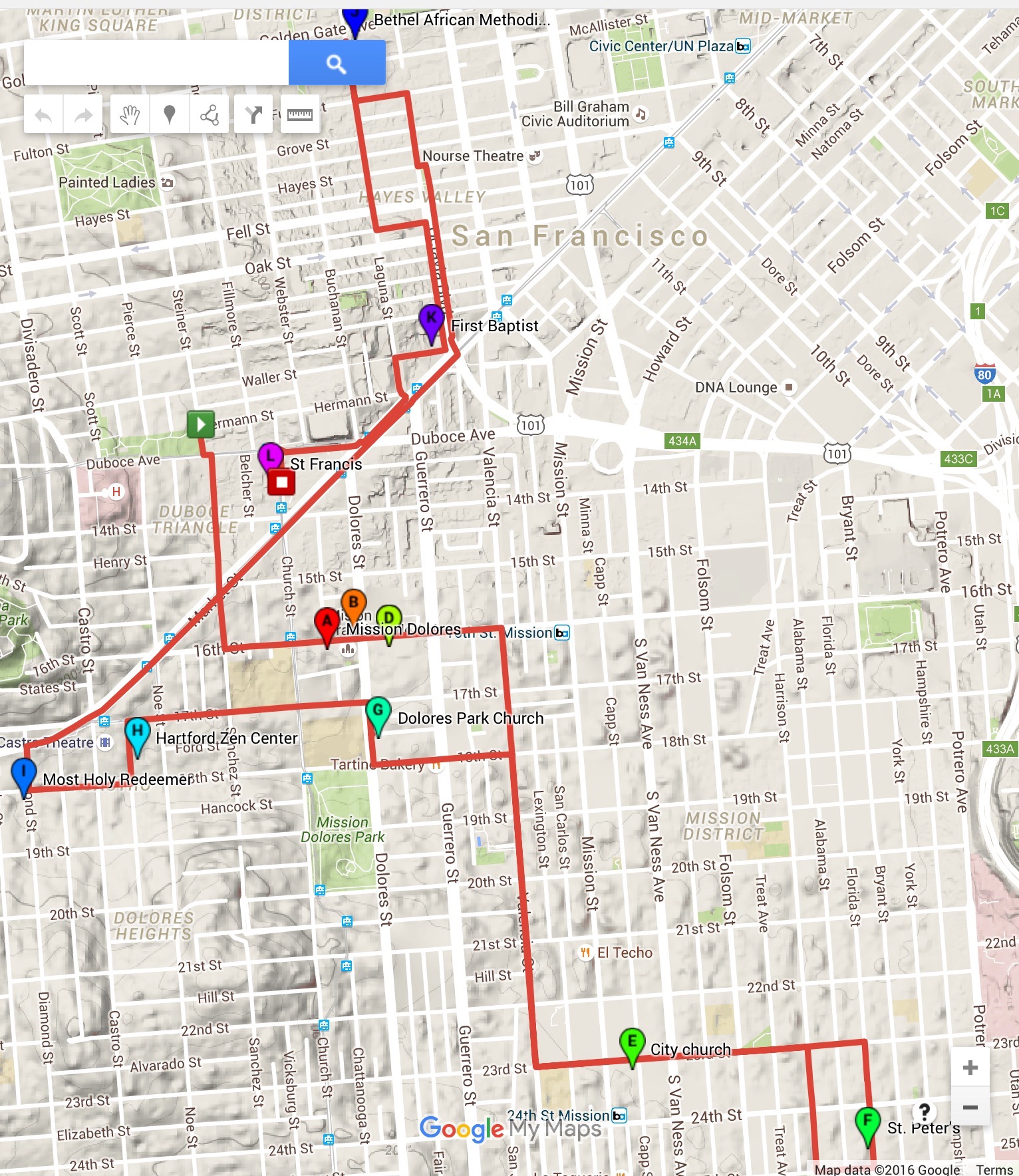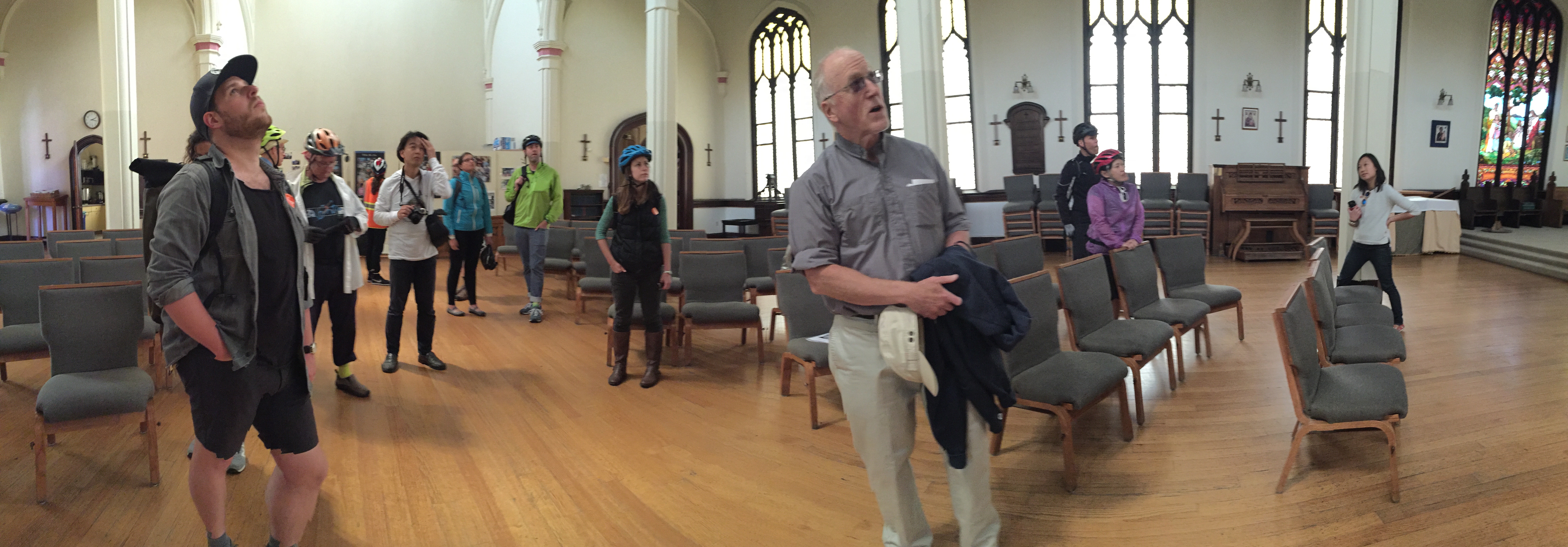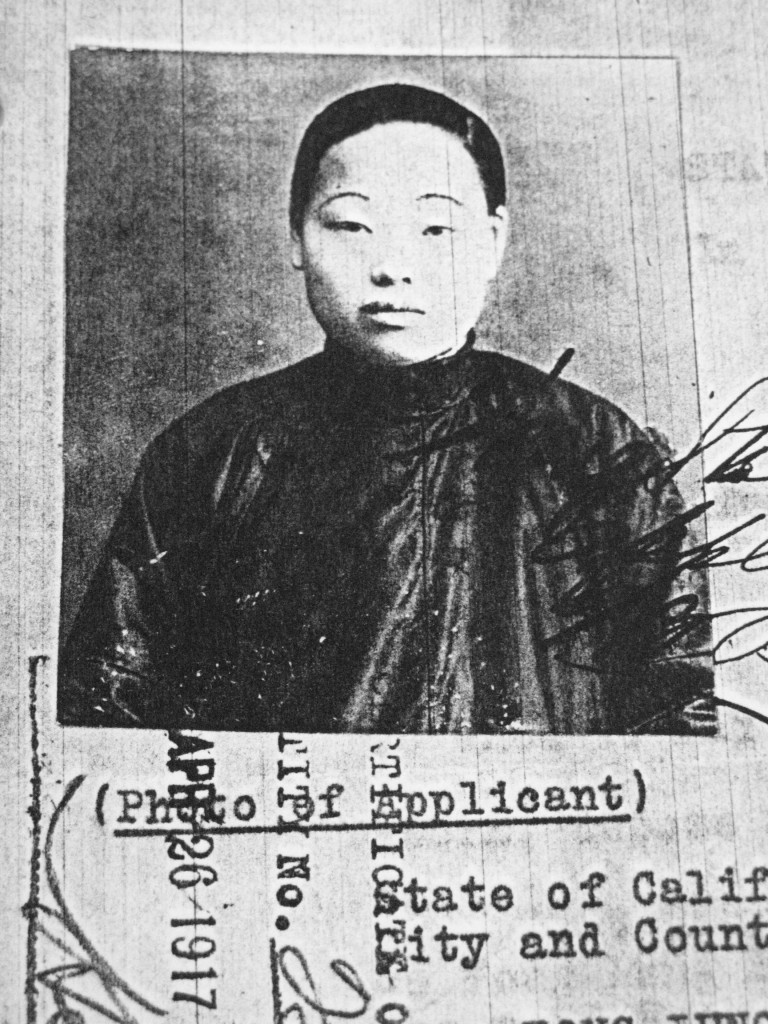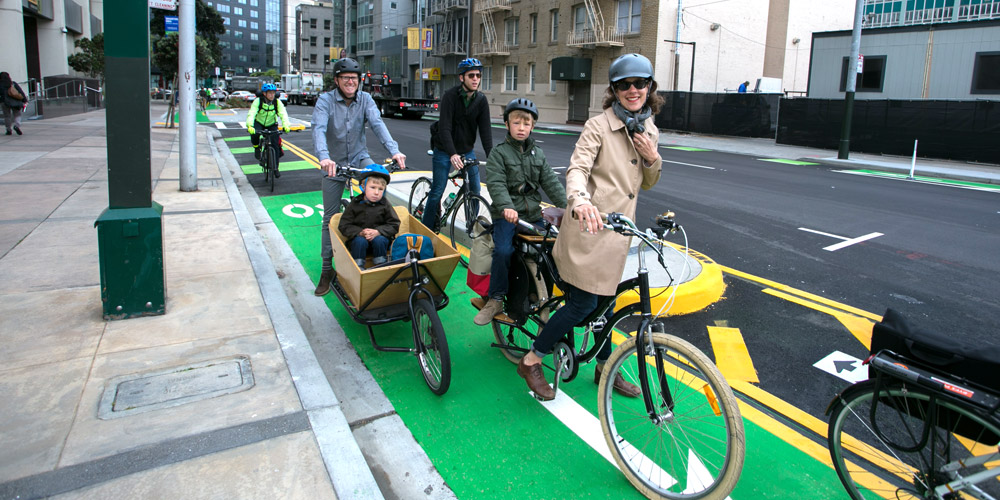The Rarely told Story of How SF’s Congregations have helped shape San Francisco

Congregations to visit on the 2nd Annual Interfaith Bike Tour
But it’s often not told how San Francisco’s churches also gave voice to SF’s people and helped shape its culture. Before all the coffee shops and performance spaces ever came to be, even before the Mission District saw its its influx of Latino culture, the church had a formative role in helping shape San Francisco. Given that San Francisco has a “touted reputation as a bastion of liberal tolerance,” the idea that SF’s churches had any influence on the City sounds foreign. But I believe telling this untold story would catalyze this story, pushing it forward among riders of the 2nd annual interfaith ride who are already seeking the welfare of San Francisco through its respective congregations.
To tell this story, we visited a variety of “sacred spaces” of different congregations in San Francisco. We stood among gardens and

The gardens of St. John’s (note the red doors on the right)
memorials in different churches where ashes of AIDS victims and refugees of war seeking sanctuary were scattered. We stood inside both modern and historical sanctuaries amidst the stained glass windows and alters as we listened to gripping testimony of how congregations stood with and advocated for past and present victims of war, housing displacement, and local law enforcement. Standing in those sacred spaces, amidst the memorials, under the spires and towers and stained glass, at even hearing the deep bellows of pipe organs, the stories of present-day advocacy and past heroes were speaking to us and captivating our hearts.

Admiring one of the sanctuaries that provided refuge for refugees and victims
Following are just a few highlights of the congregations we visited over a few hours. St. John’s the Evangelist church founded one of the City’s oldest hospitals, St. Luke’s. Standing first in St. John’s garden, then moving into their main sancturay, Father Richard Smith shared the very recent story of Mr. Lopez, shot in the back 6 times by police and how their church is advocating for his case and for many others. Father Richard also showed us the red doors of his church, red being the color that signified sanctuary. For example, in the 1980’s when refugees were escaping El Salvador, the church made a commitment that any family being deported could step through those red doors and be “safe.”…At Grace Fellowship Community Church, Pastor Craig Wong told the story of how a Presbyterian missionary (Cameron Donaldina) decades ago saved literally thousands of young women from the sex trade and from the deplorable conditions at the immigration station, essentially a prison for Chinese during the Chinese Exclusion Era. One of these women was his grandmother shown here … St. Peter’s church was another sanctuary for refugees during Ronald Reagan’s war in Central America. That’s when the mural behind me in the picture was painted (shown above the title). There, I also dramatized a few lines from a speech given by Father Peter Yorke, one of the outspoken advocates for the rights of the working man during the labor wars in the early 1900’s. In those days, the Irish Catholics played an extraordinarily influential role role in the political and social development of San Francisco up to the 1970s. But riders were also encouraged by how present day churches are having an impact on San Francisco, bringing together diverse populations, different races together serving in the prisons, legally advocating for immigrants, and so much more. We ended our ride with debriefing at the St. Francis, one of the most outspoken voices for the inclusion of LGBTQ into their clergy. The story of the church’s influence on San Francisco culture is a complex story, and not always a pretty one. As the main architect for the story, we did not shy away from the racism and imperialism woven into the story of churches in San Francisco. But by sharing just a few slices of these stories, we can honor them, and learn why we don’t have more freeways, why our neighborhoods look the way they do, why we don’t have even MORE displaced people, and learn to better seek the welfare of the people in San Francisco. As has been the case for all of SF’s history, anything we do here with an impact for San Francisco’s local people will have a national, and sometimes international impact.
of his church, red being the color that signified sanctuary. For example, in the 1980’s when refugees were escaping El Salvador, the church made a commitment that any family being deported could step through those red doors and be “safe.”…At Grace Fellowship Community Church, Pastor Craig Wong told the story of how a Presbyterian missionary (Cameron Donaldina) decades ago saved literally thousands of young women from the sex trade and from the deplorable conditions at the immigration station, essentially a prison for Chinese during the Chinese Exclusion Era. One of these women was his grandmother shown here … St. Peter’s church was another sanctuary for refugees during Ronald Reagan’s war in Central America. That’s when the mural behind me in the picture was painted (shown above the title). There, I also dramatized a few lines from a speech given by Father Peter Yorke, one of the outspoken advocates for the rights of the working man during the labor wars in the early 1900’s. In those days, the Irish Catholics played an extraordinarily influential role role in the political and social development of San Francisco up to the 1970s. But riders were also encouraged by how present day churches are having an impact on San Francisco, bringing together diverse populations, different races together serving in the prisons, legally advocating for immigrants, and so much more. We ended our ride with debriefing at the St. Francis, one of the most outspoken voices for the inclusion of LGBTQ into their clergy. The story of the church’s influence on San Francisco culture is a complex story, and not always a pretty one. As the main architect for the story, we did not shy away from the racism and imperialism woven into the story of churches in San Francisco. But by sharing just a few slices of these stories, we can honor them, and learn why we don’t have more freeways, why our neighborhoods look the way they do, why we don’t have even MORE displaced people, and learn to better seek the welfare of the people in San Francisco. As has been the case for all of SF’s history, anything we do here with an impact for San Francisco’s local people will have a national, and sometimes international impact.

One of SF’s new bike lanes
There was no better way to tell this story then by bike; it could not have been told any other way. The congregations would have been too far apart to visit by foot; it would have taken too much time to mass transit to each destination, and it would have been too prohibitive to try to park at each location. And there’s always a camaraderie inherent to traveling in an entourage by bike. And if you’re not familiar with the feasibility of biking in San Francisco, the last few years have seen a tremendous increase in bicycle infrastructure. Seems like each week, I experience new, separated bike lanes, bike signals, staging areas for turns added and more. All this has led about 100% increase in bike usage in San Francisco since 2011. Having lived and studied in bike capitals of the U.S. like Davis, CA and Fort Collins, CO, I’m personally excited about this infrastructure. Our interfaith bike tour was inclusive of all bike levels. It IS possible to cover a lot of ground without hitting hills in San Francisco (thanks for bike routes that follow underground creeks that cut in between the hills). We had everyone on the ride from newbies to everyday bike commuters. The advance Roman roads of 2000 years ago allowed for the spread of the Apostle Paul’s message; SF’s bike lanes and infrastructure was the spine that enabled the experience of this untold story to be told in the best way possible.

Planning Committee: Ralph Sinick of Bnai Emunah; Bea Chun of St. Francis; Bonnie Walton of the Bike Coalition; Alyson Jacks of UUC, Myles Cowherd of Zen Center, and me
“Work to see that the city where I sent you as exiles enjoys peace and prosperity. Pray to the Lord for it. For as it prospers you will prosper.” Jeremiah the prophet, Chapter 29, verse 7